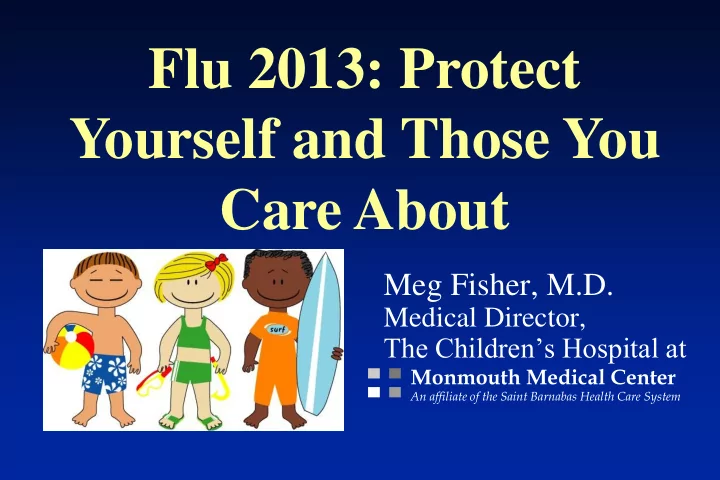

Flu 2013: Protect Yourself and Those You Care About Meg Fisher, M.D. Medical Director, The Children’s Hospital at Monmouth Medical Center An affiliate of the Saint Barnabas Health Care System
Disclosures I have no disclosures. If I mention off label uses of drugs or vaccines, I will tell you it is an off label use.
Objectives • Counsel regarding influenza vaccination • Recognize influenza • Prescribe antiviral agents for children
“I had a little bird. His name was Enza. I opened the window. And in flew Enza.” A chant popular during the influenza pandemic of 1918
Influenza Viruses • Orthomyxovirus • Types A, B and C • Yearly winter outbreaks of A and B • Hemagglutinin (H) • Neuraminidase (N)
Antigenic Changes • Shift: Major change in surface Pandemics To date with A only • Drift: Minor change in surface Yearly outbreaks
Influenza Pandemics 1918: H1 1957: H2 1968: H3 1977: H1 2009: H1N1
Animal strains • Birds: virus in the gut • Pigs: virus in the respiratory tract • Pig, avian and human influenza exchange genes to form novel strains: 2009 H1N1, H3N2v
Influenza: The Illness • Symptoms: fever, chills, aches, malaise, myalgia, gastrointestinal in younger • Signs: fever, pharyngitis, rhinitis, cough
Epidemiology Usually winter outbreaks Cruise ship outbreaks - Alaska in summer Children - major role as transmitters Droplet and contact spread Contagious 1 day before to 7 days after Incubation 1 to 3 days
2012 to 2013 Season
Children and Influenza • Highest attack rates: 15-42% yearly • Highest hospitalization rates • Major transmitters: shed higher titers for longer times, poor hygiene and less control of nasal excretions
Complications of Influenza • Bacterial superinfection: pneumonia, otitis media, sinusitis • Reye syndrome • Triggers asthma • Myositis • Encephalitis
Influenza Diagnosis • Clinical • Culture: throat gargle or nasal wash • Antigen detection: rapid but lacks sensitivity (70% at best) • Serology not clinically useful
Management of Influenza • Symptomatic: Antipyretics may prolong viral shedding Aspirin contraindicated • Complementary therapies abound • Antivirals: several available
Antivirals for Influenza • Consider for children with underlying problems which increase risk • Severe illness • Special circumstances • Start early for maximal effect
Children at Risk • Underlying diseases: the usual suspects • Neuromuscular and developmental • Obese • Age under 5 but especially under 2 years
Zanamivir (Relenza) • Neuraminidase inhibitor, prevents viral entry • Effective for influenza A and B • Dose: 10 mg bid, inhaled • Precaution in patients with bronchospasm
Oseltamivir (Tamiflu) • Neuraminidase inhibitor, prevents viral entry • Effective for influenza A and B • Dose: varies by age and weight: 3 mg/kg/day under 1 yr; 45 mg bid if 15 to 23 kg; 60 if 23 to 40 kg; 75 if over 40 kg • Side effects mild, gastrointestinal
Prevention of Influenza Infection control: • Hand washing and hand hygiene • Isolation: masks/goggles – patients/staff • Limit visitors/triage patient visits • Respiratory hygiene: tissues and sleeves • Keep your distance: 3 to 6 feet • Stay home when you are sick
2013-2014 Vaccines • One formulation of live attenuated: nasal • Eleven formulations of inactivated: 10 given intramuscular; one intradermal • Dose for intramuscular: <3years - 0.25 ml; 3+ - 0.5 ml • Formulations licensed for various ages http://www.cdc.gov/flu/professionals/acip/20 13-interim-recommendations.htm
Live Attenuated Vaccine • Cold adapted virus (LAIV) • Won’t survive body temperature • Same process as seasonal • For ages 2 to 49 years • Not for use in those with risks • This year quadrivalent: 2 A + 2 B
Inactivated Influenza Vaccines • Composition altered yearly • Three or four strains: 2 A, 1 or 2 B • For use in all over 6 months • Multiple formulations; age matters • Egg antigen content varies • Cell culture/recombinant; age >18 yr
Inactivated Influenza Vaccines • IIV3: Afluria (9+); Fluarix (3+); Flucelvax (18+); FluLaval (18+); Fluvirin (4+); Fluzone (6mo +); Fluzone Intradermal (18- 64); Fluzone High-Dose (65+) • IIV4: Fluarix Quad. (3+); Fluzone Quad (6mo+) • REV3: FluBlok (18-49)
Seasonal Influenza Vaccine Schedule • Yearly – start as soon as you get it • Children under 3 years: lower dose • Child under 9: two doses first season • Contraindicated in persons with anaphylaxis to chicken or eggs
Chemoprophylaxis • Agents: Oseltamivir, Zanamivir • Indications: unable to vaccinate, pending response to vaccine, following household exposure, outbreak control
Resources www.cdc.gov/flu/ www.aap.org – members – search takes you to Preparing Your Practice for Providing Influenza Vaccines Table with vaccines and codes www.cdc.gov/vaccinesafety/
Recommend
More recommend